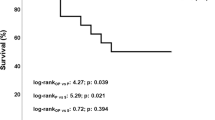Summary
The aim of the present study was to assess whether the presence of polymorphonuclear leukocytes in the first stage of fracture repair was of any importance. In anesthetized male Wistar rats, a transverse osteotomy was performed at midshaft in one femur and immediately stabilized by an intramedullary Kirschner nail. The animals were allowed unprotected weight bearing immediately. Nine animals were made neutropenic before operation by injection of a specific rat polymorphonuclear leukocyte antiserum (antineutrophil serum, ANS) raised in sheep. The number of circulating polymorphonuclear leukocytes were kept below 20% of their normal value for 72 h postoperatively by intraperitoneal injections of ANS every 12h. Control animals were injected with the same amount of normal sheep serum (NSS). All animals received cefuroxime (100 mg/kg day) concomitantly with the ANS injections. Six weeks after operation the animals were killed, the amount of callus formation was measured, and the bones were radiologically examined. The nails were then removed and both the healing fractures and the nonoperated femurs mechanically tested for bending. There were no differences in the amount of callus measured or in radiological healing. However, there was a significantly higher bending moment in femurs from animals treated with ANS than in those given NSS (P < 0.02). No differences were observed in rigidity or total energy absorption.
Similar content being viewed by others
References
Babior BM (1978) Oxygen-dependent microbial killing by phagocytes. N Engl J Med 298:659–668, 721–725
Engsæter LB, Ekeland A, Langeland N (1978) Methods for testing the mechanical properties of the rat femur. Acta Orthop Scand 49:512–518
Freeman BA, Crapo JD (1982) Free radicals and tissue injury. Lab Inv 47:412–426
Harlan JM (1985) Leukocyte-endothelial interactions. Blood 65:513–525
Høgstrøm H, Haglund U (1985) Neutropenia prevents decrease in strength of rat intestinal anastomosis; partial effect of oxygen free radical scavengers and allopurinol. Surgery 99:716–720
Korthuis RJ, Granger DN, Townsley MI, Taylor AE (1985) The role of oxygen-derived free radicals in ischemia-induced increases in canine skeletal muscle vascular permeability. Circ Res 57:599–609
Korthuis RJ, Grisham MB, Granger DN (1988) Leukocyte depletion attenuates vascular injury in postischemic skeletal muscle. Am J Physiol 254:H823–827
Ley K, Arfors K-E (1982) Changes in macromolecular permeability by intravascular generation of oxygen-derived free radicals. Microvasc Res 24:25–33
Macartney HW, Tschesche H (1983) Latent and active human polymorphonuclear leukocyte collagenase: isolation, purification and characterization. Eur J Biochem 130:71–78
McCord JM (1987) Oxygen-derived radicals: a link between reperfusion injury and inflammation. Fed Proc 42:2402–2406
Murphy KR (1976) The neutrophile. Plenum, New York
Mølster AO, Gjerde NR (1984) Biomechanical effects of instability on fracture healing in the rat. Acta Orthop Scand 55: 342–346
Romson JL, Hook BG, Kunkel SL, Abrams GD, Schork MA, Lucchesi BR (1983) Reduction of the extent of ischemic myocardial injury by neutrophil depletion in the dog. Circulation 67:1016–1023
Samuelsson B, Hammarström S, Borgeat P (1979) Pathways of arachidonic acid metabolism. In: Weissman G, Samuelsson B, Paoletti R (ededs). Raven, New York, p 405
Sandler H, Högstorp H, Lundberg C, Gerdin B (1987) Antiserum-induced neutropenia in the rat: characterization of a rabbit anti-rat neutrophil serum. Br J Pathol 68:71–80
Starkey PM, Barrett AJ, Burleigh MC (1977) The degradation of articular collagen by neutrophil proteinases. Biochem Biophys Res Com 483:386
Till GO, Johnson KJ, Kunkel R, Ward PA (1982) Intravascular activation of complement and acute lung injury. Dependency on neutrophils and toxic oxygen metabolites. J Clin Invest 69:1126–1135
Weiss SJ (1986) Oxygen, ischemia, and inflammation. Acta Physiol Scand 126 [Suppl 548]:9–38
Author information
Authors and Affiliations
Rights and permissions
About this article
Cite this article
Grøgaard, B., Gerdin, B. & Reikerås, O. The polymorphonuclear leukocyte: has it a role in fracture healing?. Arch Orthop Trauma Surg 109, 268–271 (1990). https://doi.org/10.1007/BF00419942
Received:
Issue Date:
DOI: https://doi.org/10.1007/BF00419942




